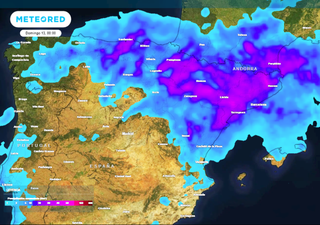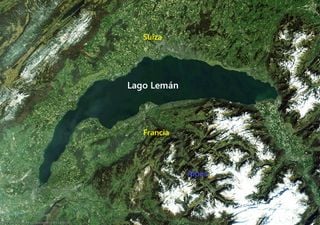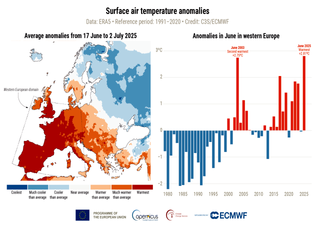WMO STATEMENT ON THE SCIENTIFIC BASIS FOR, AND LIMITATIONS OF, WEATHER FORECASTING AND CLIMATE PROJECTIONS
RAM. Por su importancia, reproducimos este artículo bajado directamente desde la página de la OMM y en inglés. Se repasan las bases científicas y limitaciones que existen hoy en día para la predicción...
RAM. Por su importancia, reproducimos este artículo bajado directamente desde la página de la OMM y en inglés. Se repasan las bases científicas y limitaciones que existen hoy en día para la predicción del tiempo y clima.
1.2 Over the past few decades, the impact of improved observational capability, increased scientific understanding and more sophisticated and skilful numerical models, and other forecasting tools has gradually changed the public perception of weather forecasting from one in which the community assumed that the forecasts would often be wrong, to one in which they are expected to be right. Indeed, three-day forecasts for surface pressure are as good as one day forecasts 20 years ago, which is a great scientific achievement. This improvement is continuing into the twenty-first century, perhaps at an even more rapid pace.
1.3 Notwithstanding these successes, some uncertainty in forecasts remains and 100 per cent success will never be achieved. There is the risk however, that the public will come to expect that forecasts should always be right; and when they are wrong, it must be the result of incompetence, negligence or some other culpable form of system failure. What should be better understood is that with present (and any foreseeable) future states of the science, some meteorological phenomena will remain inherently unpredictable, and the more extreme the phenomena, the more likely that this will be so.
1.4 This document has been prepared by experts from within the WMO’s Atmospheric Research and Environment Programme to reflect the current state of the science of weather forecasting and climate projections. The contents may be of broad interest to scientists, users of weather forecasts, funding agencies and policy makers. However, the intent of this Statement is to celebrate the achievements while documenting the reasons for uncertainties in weather forecasting and climate projections and while explaining how forecasting methods are designed to minimize and quantify uncertainty. It is expected that this will contribute to a mutual understanding between the science and use community, allowing for improved understanding of this shared challenge.
2. The science of weather forecasting
Dynamical and physical processes within the atmosphere, and interactions with the surroundings (e.g. land, ocean, and ice surfaces), determine the evolution of the atmosphere and, hence, the weather. Scientifically-based weather forecasts are possible if the processes are well enough understood and if the current state of the atmosphere is well known enough, for predictions to be made of future states. Weather forecasts are prepared using a largely systematic approach, involving observation and data assimilation, process understanding, prediction and dissemination. Each of these components has, and will continue, to benefit from advances in science and technology.
2.1 Observations and data assimilation
2.1.1 Over the past few decades, substantial advances in science have resulted in improved and more efficient methods for making and collecting timely observations, from a wide variety of sources including radar and satellites. Using these observations in scientifically-based methods has caused the quality of weather forecasts to increase dramatically, so that people around the world have come to rely on weather forecasts as a valued input to many decision-making processes.
2.1.2 Computer-generated predictions are initialised from a description of the atmospheric state built from past and current observations in a process called data assimilation, which uses the NWP model (see paragraph 2.3.2) to summarize and carry forward in time information from past observations. Data assimilation is very effective at using the incomplete coverage of observations from various sources to build a coherent estimate of the atmospheric state. But, like the forecast, it relies on the NWP model and cannot easily use observations of scales and processes not represented by the model.
2.1.3 The international scientific community is emphasizing the still very poorly observed areas as being a limiting factor in the quality of some forecasts. As a consequence, there is a continued need for improved observation systems and methods to assimilate these into NWP models.
2.2 Understanding of the atmosphere: inherent limitations to predictability
2.2.1 The scientific understanding of physical processes has made considerable progress through a variety of research activities, including field experiments, theoretical work and numerical simulation. However, atmospheric processes are inherently non-linear and not all physical processes can be understood or represented in NWP models. For instance, the wide variety of possible cloud water and ice particles must be highly simplified, as are small cumulus clouds that can lead to rain showers. Continued research effort using expected improvements in computer technology and physical measurements will enable these approximations to be improved. Even then, it will still not be possible to represent all atmospheric motions and processes.
2.2.2 There is a wide spectrum of patterns of atmospheric motion, from the planetary scale down to local turbulence. Some are unstable and are arranged so that flow is amplified using, for example, energy from heating and condensation of moisture. This property of the atmosphere means that small uncertainties about the state of the atmosphere will also grow, so that eventually the unstable patterns cannot be precisely forecast. How quickly this happens depends on the type and size of the motion. For convective motions such as thunderstorms, the limit is of the order of hours, while for large scales of motion it is of the order of two weeks.
2.3 Weather prediction
2.3.1 Nowcasting:
Forecasts extending from 0 out to 6 to 12 hours are based upon a more observations-intensive approach and are referred to as nowcasts. Traditionally, nowcasting has focused on the analysis and extrapolation of observed meteorological fields, with a special emphasis on mesoscale fields of clouds and precipitation derived from satellite and radar. Nowcast products are especially valuable in the case of small-scale hazardous weather phenomena associated with severe convection and intense cyclones. In the case of tropical cyclones, nowcasting is an important detection and subsequent short-term prediction approach that provides forecast value beyond 24 hours in some cases. However, the time rate of change of phenomena such as severe convection is such that the simple extrapolation of significant features leads to a product that deteriorates rapidly with time — even on timescales of the order of one hour. Thus, methods are being developed that combine extrapolation techniques with NWP, both through a blending of the two products and through the improved assimilation of detailed mesoscale observations. These are inherently difficult tasks and, although accuracy and specificity will improve over coming years, these products will always involve uncertainty regarding the specific location, timing and severity of weather events such as thunder and hail storms, tornadoes and downbursts.
2.3.2 Numerical weather prediction:
Forecasts for lead times in excess of several hours are essentially based almost entirely on NWP. In fact, much of the improvement in the skill of weather forecasts over the past 20 years can be attributed to NWP computer models, which are constructed using the equations governing the dynamical and physical evolution of the atmosphere. NWP models represent the atmosphere on a three-dimensional grid, while typical operational systems in 2001 use a horizontal spacing of 50–100 km for large-scale forecasting and five to 40 km for limited area forecasting at the mesoscale. This will improve as more powerful computers become available. Only weather systems with a size several times the grid spacing can be accurately predicted, so phenomena on smaller scales must be represented in an approximate way using statistical and other techniques. These limitations in NWP models particularly affect detailed forecasts of local weather elements, such as cloud and fog and extremes such as intense precipitation and peak gusts. They also contribute to the uncertainties that can grow chaotically, ultimately limiting predictability.
2.3.3 Ensemble prediction:
Uncertainty always exists - even in our knowledge of the current state of the atmosphere. It grows chaotically in time, with much of the new information introduced at the beginning no longer adding value, until only climatological information remains. The rate of growth of this uncertainty is difficult to estimate since it depends upon the three-dimensional structure of the atmospheric flow. The solution is to execute a group of forecasts - an ensemble - from a range of modestly different initial conditions and/or a collection of NWP models with different, but equally plausible, approximations. If the ensemble is well designed, its forecasts will span the range of likely outcomes, providing a range of patterns where uncertainties may grow. From this set of forecasts, information on probabilities can be derived automatically, tailored to users’ needs. Forecast ensembles are subject to the limitations of NWP discussed earlier. Additionally, since the group of forecasts are being computed simultaneously, less computer power is available for each forecast. This requires grid spacings to be increased, making it more difficult to represent some severe weather events of smaller horizontal scale. Together with the limited number of forecasts in an ensemble, this makes it harder to estimate probabilities of very extreme and rare events directly from the ensemble. Moreover it is not possible to modify the NWP models used to sample properly modelling errors, so sometimes all models will make similar errors.
2.3.4 Operational meteorologist:
There remains a critical role for the human forecaster in interpreting the output nd in reconciling sometimes seemingly conflicting information from different sources. This role is especially important in situations of locally severe weather. Although vigorous efforts are being made to provide forecasters with good quality systems such as interactive workstations for displaying and manipulating the basic information, they still have to cope with vast amounts of information and make judgements within severe time constraints. Furthermore, forecasters are challenged to keep up to date with the latest scientific advances.
3. Prediction at seasonal to inter-annual timescales
3.1 Beyond two weeks, weekly average predictions of detailed weather have very low skill, but forecasts of one-month averages, using NWP with predicted sea surface temperature anomalies, still have significant skill for some regions and seasons to a range of a few months.
3.2 At the seasonal timescale, detailed forecasts of weather events or sequences of weather patterns are not possible. As mentioned above, the chaotic nature of the atmosphere sets a fundamental limit of the order of two weeks for such deterministic predictions, associated with the rapid growth of initial condition errors arising from imperfect and incomplete observations. None the less, in a limited sense, some predictability of temperature and precipitation anomalies has been shown to exist at longer lead times out to a few seasons. This comes about because of interactions between the atmosphere, the oceans, and the land surface, which become important at seasonal timescales.
3.3 The intrinsic timescales of variability for both the land surface and the oceans are long compared to that of the atmosphere, due in part to relatively large thermal inertia. Ocean waves and currents are slow in comparison to their atmospheric counterparts, due to the large differences in density structure. To the extent that the atmosphere is connected to the ocean and land surface conditions, then, a degree of predictability may be imparted to the atmosphere at seasonal timescales. Such coupling is known to exist particularly in the tropics, where patterns of atmospheric convection ultimately important to global scale weather patterns are quite closely tied to variations in ocean surface temperature. The most important example of this coupling is found in the ENSO phenomenon, which produces large swings in global climate at intervals ranging from two to seven years.
3.4 The nature of the predictability at seasonal timescales must be understood in probabilistic terms. It is not the exact sequence of weather that has predictability at long lead times (a season or more), but rather some aspects of the statistics of the weather - for example, the mean or variance of temperature/precipitation over a season — that has potential predictability. Though the weather on any given day is entirely uncertain at long lead times, the persistent influence of the slowly evolving surface conditions may change the odds for a particular type of weather occurring on that day. In rough analogy to the process of throwing dice, the subtle but systematic influence of the boundary forcing can be likened to throwing dice that are "loaded". On any given throw, we cannot foretell the outcome, yet after many throws the biased dice will favour a particular outcome over others. This is the sort of limited predictability that characterizes seasonal prediction.
3.5 Currently, seasonal predictions are made using both statistical schemes and dynamical models. The statistical approach seeks to find recurring patterns in climate associated with a predictor field such as sea surface temperature. Such models have demonstrated skill in forecasting El Niño and some of its global climate impacts. The basic tools for dynamical prediction are coupled models - models that include both the atmosphere and the other media of importance, particularly the oceans. Such models are initialised using available observations and integrated forward in time to produce a seasonal prediction. The issue of uncertainty is handled using an ensemble approach, where the climate model is run many times with slightly different initial conditions (within the range of observation errors or sampling errors). From this, a distribution of results is obtained, whereupon statistics of the climate can be estimated. Recently, encouraging results have been obtained from ensemble outputs of more than one model being combined.
3.6 There are several limitations attending current predictions. Most coupled models (and to a lesser extent uncoupled models) exhibit some serious systematic errors that inevitably reduce forecast skill. Data availability is a limitation for both statistical models and for dynamical models. In the latter case, very limited information is available for much of the global oceans and for the land surface conditions. Also, current initialisation methods do not account properly for systematic model errors, further limiting forecast performance. A final set of limitations arises for practical reasons. Due to resource requirements, most seasonal predictions cannot be done at resolutions comparable to weather prediction. Furthermore, rather small ensemble sizes (of the order of 10) are used for some models, certainly less than is optimal for generating robust probabilistic forecasts. Current research is addressing the potential for regional "downscaling" of climate forecasts by various means and the possibilities for more detailed probabilistic climate information from expanded ensembles of one or more models.
3.7 Possible use of seasonal forecasts is currently being explored in various contexts. In each case, effective use will require careful attention to the issue of uncertainty inherent in seasonal forecasts. Future advancements can be expected to improve the estimates of uncertainty associated with forecasts, thus allowing better use of forecast products.
4. Projection of future climate
4.1 As explained above, based on the current observed state of the atmosphere, weather prediction can provide detailed location and time-specific weather information on timescales of the order of two weeks. Some predictability of temperature and precipitation anomalies has been shown to exist at longer lead times out to a few seasons. This comes about because of interactions between the atmosphere, the oceans, and the land surface, which become important at seasonal timescales. At longer timescales, the current observed state of the atmosphere and even those large-scale anomalies which provide predictive skill at seasonal to inter-annual timescales are no longer able to do so due to the fundamental chaotic nature of the Earth-atmosphere system. However, long-term changes in the Earth-atmosphere system at climate timescales (decades to centuries) are dependent on factors which change the balance of incoming and outgoing energy in the Earth-atmosphere system. These factors can be natural (e.g. changes in solar output or volcanoes) or human induced (e.g. increased greenhouse gases). Because simulations of possible future climate states are dependent on prescribed scenarios of these factors they are more accurately referred to as "projections" not "predictions" or "forecasts".
4.2 In order to perform climate projections, physically-based climate models are required in order to represent the delicate feedbacks which are crucial on climate timescales. Physical processes and feedbacks that are not important at NWP or even at the timescales of seasonal prediction become crucial when attempting to simulate climate over long periods, e.g. cloud-radiation interaction and feedback, water vapour feedback (and correctly modelling long-term trends in water vapour), ocean dynamics and processes (in particular an accurate representation of the thermohaline circulation). The treatments of these key features are adequate to reproduce many aspects of climate realistically though there remain many uncertainties associated with clouds and aerosols and their radiative effects, and many ocean processes. Nevertheless, there is reasonable confidence that state-of-the-art climate models do provide useful projections of future climate change. This confidence is based on the demonstrated performance of models on a range of space timescales.
4.3 Notably, the understanding of key climate processes and their representation in models (such as the inclusion of sea-ice dynamics and more realistic ocean heat transport) has improved in the past few years. Many models now give satisfactory simulations of climate without the need for non-physical adjustments of heat and water fluxes at the ocean-atmosphere interface used in earlier models. Moreover, simulations that include estimates of natural and anthropogenic forcing are well able to reproduce observed large-scale changes in surface temperature over the twentieth century. This large-scale consistency between models and observations lends confidence in the estimates of warming rates projected over the next century. The simulations of observed natural variability (e.g. ENSO, monsoon circulations, the North Atlantic Oscillation) have also improved.
4.4 On the other hand, systematic errors are still all too apparent, e.g. in simulated temperature distributions in different regions of the world or in different parts of the atmosphere, in precipitation fields, clouds (in particular marine stratus). One of the factors that limits confidence in climate projections is the uncertainties in external forcing (e.g. in predicting future atmospheric concentrations of carbon dioxide and other greenhouse gases, and aerosol loadings).
4.5 As with NWP and seasonal forecasts, ensembles of climate projections are also extremely important. Ensembles enable the magnitude and effects of natural climate variability to be gauged and affect its impact on future projections, and thereby permit any significant climate change signal to be picked out more clearly statistically (the magnitude of natural climate variability will be comparable with that of climate change for the next few decades).
5. Dissemination to end-users
5.1 The weather forecasts have to be communicated to a vast array of users such as emergency managers, air traffic controllers, flood forecasters, public event managers, etc. in a timely and user-applicable form. This in itself poses another major challenge that is increasingly benefiting from advances in information technology. Predictions at seasonal to inter-annual timescales and climate projections are also being used by an increasingly wide range of users.
5.2 The value of forecasts to decision makers is greatly enhanced if the inherent uncertainty can be quantified. This is particularly true of severe weather, which can cause such damage to property and loss of life that precautions may be well advised even if the event is unlikely, but possible. Probabilities are a natural way of expressing uncertainty. A range of possible outcomes can be described with associated probabilities and users can then make informed decisions allowing for their particular costs and risks.
5.3 Forecasts expressed as probabilities, or ensembles, contain much more information than deterministic forecasts, and it is difficult to convey it all to users. Broadcast forecasts can only give a broad picture of the most likely outcome, with perhaps some idea of important risks. Each user’s decision may be based on the probabilities of a few specific occurrences. What these are, and the probability thresholds for acting on the forecasts, will differ. So for important user decisions it is necessary to apply their particular criteria to the detailed forecast information.
6. Conclusions
6.1 The skill in weather forecasting has advanced substantially since the middle of the twentieth century, largely supported by the advancement of computing, observation and telecommunications systems, along with the development of NWP models and the associated data-assimilation techniques. This has been greatly facilitated because of the vast experience of both forecasters and decision makers in producing and in using forecast products. Nevertheless, each component within the science and technology of weather forecasting and climate projection has its own uncertainties. Some of these are associated with a lack of a complete understanding of, or an inherent limitation of, the predictability of highly complex processes. Others are linked still to the need for further advances in observing or computing technology, or to an inadequate transfer between research and operations. Finally, one cannot underestimate the importance of properly communicated weather forecasts to well-educated users.
6.2 Without a doubt, significant benefits will result from continued attention to scientific research and the transfer of knowledge gained from this work into the practice of forecasting. Furthermore, a recognition of the limitations of weather forecasts and climate projections, and when possible, an estimate of the degree of uncertainty, will result in the improved use of forecasts and other weather information by decision makers. Ultimately the objective is for the scientific and user communities to work better together, realizing even greater benefits.
Fuente: OMM (Organización Meteorológica Mundial)
Bajate este reportaje en pdf (154 Kb)








